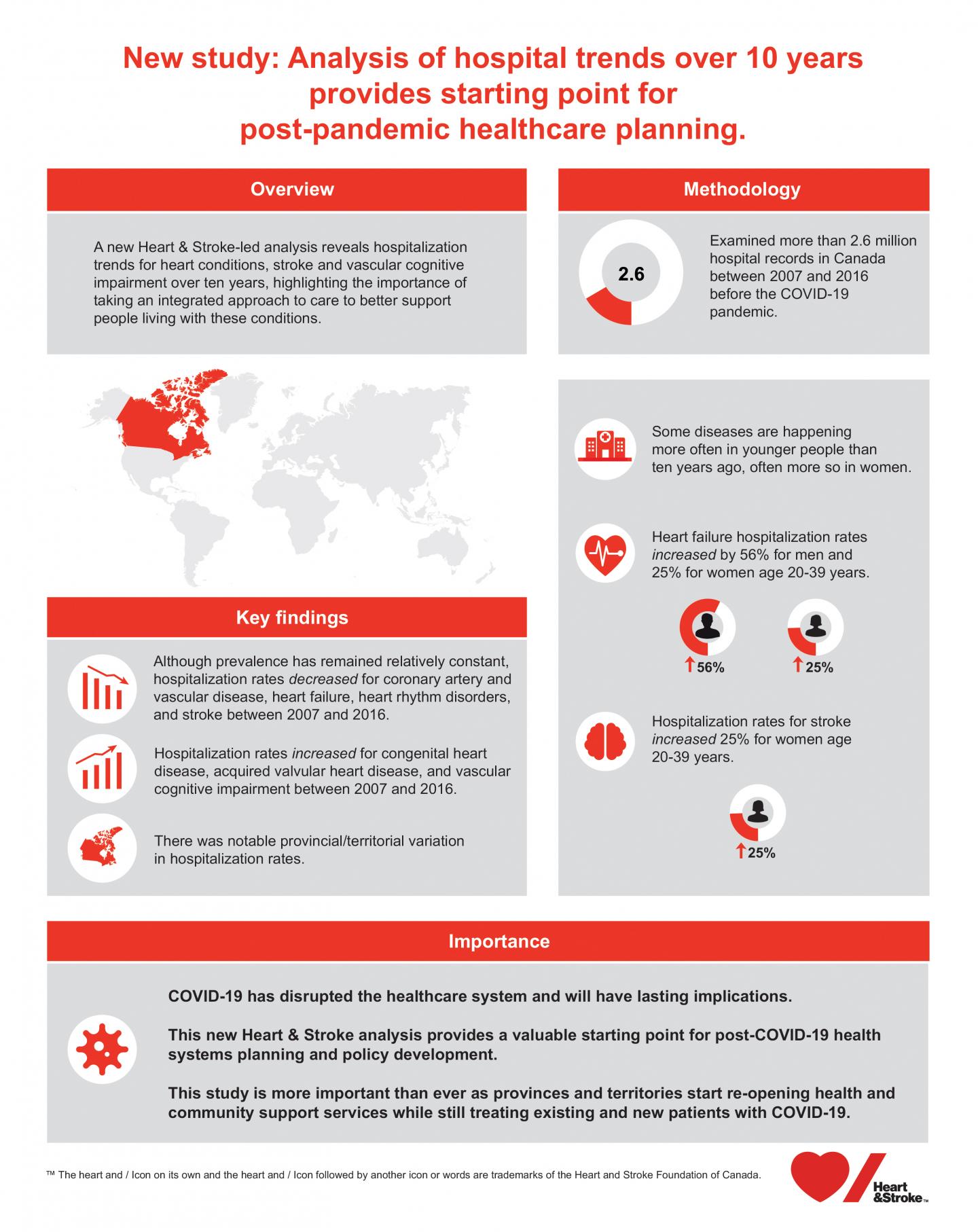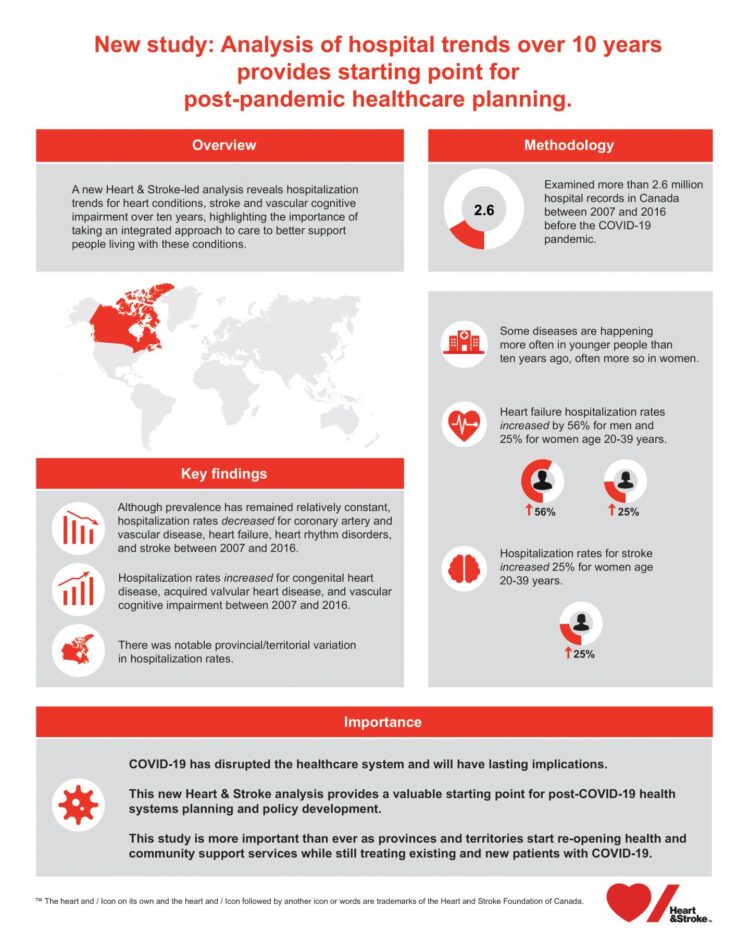Analysis of ten years of inpatient records published in the Canadian Journal of Cardiology yields important insights into the changing patterns of hospitalizations for heart conditions, stroke, and vascular cognitive impairment in Canada

Credit: Heart & Stroke, Canada
An analysis of patient records in Canada provides important new insights into changing patterns of inpatient healthcare utilization. Between 2007 and 2016, standardized hospitalization rates declined for coronary artery and vascular disease, heart rhythm disorders, stroke, and heart failure but increased for some important conditions: acquired valvular heart disease; vascular cognitive impairment; and congenital heart disease. The study appears in the Canadian Journal of Cardiology, published by Elsevier.
“Recent data on hospitalizations in Canada for a comprehensive set of cardiovascular diseases, stroke, and vascular cognitive impairment were lacking,” explained lead investigator Cindy Y.Y. Yip, PhD, Heart and Stroke Foundation of Canada, Toronto, ONT, Canada. “This is a unique study that reports recent Canadian hospitalization data for a comprehensive set of heart and stroke diseases and also reports how hospitalization trends differ between provinces/territories, age groups, and males and females.”
Investigators tracked more than 2.6 million hospital records from 2007 to 2016 from the Canadian Institute for Health Information (CIHI) Discharge Abstract Database for patients up to 105 years old. They analyzed the records for diseases that align with the Heart and Stroke Foundation of Canada’s six focus areas. These are the six disease groups that together represent the greatest burden on the health of people in Canada, on the economy, and on society: coronary artery and vascular disease; heart failure; heart rhythm disorders; structural heart disease (including congenital heart disease and acquired valvular heart disease); stroke; and vascular cognitive impairment. Data were available for all provinces and territories except Quebec.
Between 2007 and 2016, standardized hospitalization rates in Canada declined for coronary artery and vascular disease (27.4 percent) and heart rhythm disorders (16.8 percent), with relatively small decreases for stroke and heart failure. Contributing factors included increased multidisciplinary outpatient management such as specialized outpatient clinics for heart failure and atrial fibrillation and stroke prevention clinics; improvements in treatment and reductions in some medical risk factors such as hypertension and cholesterol levels; and better management of lifestyle risk factors such as smoking, poor diet, and physical inactivity.
However, there were notable increases for acquired valvular heart disease (31.1 percent), congenital heart disease (7.2 percent), and vascular cognitive impairment (23.4 percent). Contributing factors to these increases included the impact of an aging population, increased prevalence of dementia, and increases in the survival of congenital heart disease patients to adulthood due to treatment advances.
“The decrease in standardized hospitalization rates for some conditions suggests increased adoption of multidisciplinary outpatient management of these conditions,” noted first author Leigh C.P. Botly, PhD, Heart and Stroke Foundation of Canada, Toronto, ONT, Canada. “This highlights the importance of an integrated care approach to disease management and the need to assess how these conditions are being managed at the community level by primary healthcare providers and specialized clinics.”
This study also reports how hospitalization trends differ between age groups and sex. Heart failure, acquired valvular heart disease, and stroke are impacting people in Canada at earlier life stages than 10 years ago, especially for women. For example, heart failure hospitalization rates increased by 56 percent for men and 25 percent for women age 20-39 years. Hospitalization rates for stroke increased 25 percent for women aged 20-39 years, likely reflecting the increase in stroke risk during pregnancy. This was not true for males in the same age group. The increase in hospitalization rates for acquired valvular heart disease was much more pronounced for females (+65.7 percent) than males (+15.9 percent) aged 20-39 years.
“To improve the care for the people we serve, we must understand the pattern of change rather than static snapshots,” commented Dr. Yip. “Ultimately we want fewer people to be diagnosed with these conditions. For those who do experience them, we hope they can use their energy to focus more on their own recovery and experience a better quality of life rather than having to navigate a fragmented healthcare system.”
“This report describes the pattern of change from the past decade and is a first step in developing baseline data to inform healthcare policy, prevention strategy, and system planning. In the current landscape, these trends may be essential to help us understand the impact of COVID-19 on our healthcare system,” Dr. Yip continued.
“This study provides important insights on the changing epidemiology of cardiovascular disease in Canada,” commented Daniel G. Hackam, MD, PhD, Division of Clinical Pharmacology, Departments of Medicine, Clinical Neurological Sciences and Epidemiology and Biostatistics, Western University, London, ONT, Canada, in an accompanying editorial. “A renewed emphasis on treating and preventing major risk factors in younger age groups is needed to reverse disturbing trends in cardiovascular disease hospitalizations in young and middle-aged adults. Similarly, increased rates of vascular cognitive impairment also suggest that more attention needs to be paid to midlife antecedent risk factors such as hypertension and diabetes, if the coming epidemic of dementia is to be prevented.”
—
Notes for editors
The article is “Recent Trends in Hospitalizations for Cardiovascular Disease, Stroke and Vascular Cognitive Impairment in Canada,” by Leigh C.P. Botly, PhD, M. Patrice Lindsay, RN, PhD, Sharon L. Mulvagh, MD, Michael D. Hill, MD, MSc, Cristina Goia, MSc, Michelle Martin-Rhee, PhD, Leanne K. Casaubon, MD, MSc, and Cindy Y.Y. Yip, PhD (https:/
The editorial is “The Changing Epidemiology of Cardiovascular Disease: Two Steps Forward, One Step Back,” by Daniel G Hackam, MD, PhD (https:/
The authors thank the Canadian Institute for Health Information (CIHI) for the use of their database in this study and also acknowledge the generosity of Heart and Stroke donors and volunteers.
Full text of the articles is available to credentialed journalists upon request. Contact Eileen Leahy at +1 732 238 3628or [email protected] to obtain copies. Journalists wishing to speak to the study’s authors should contact Megan Radford, Heart & Stroke, Canada, at +1 416 938 9483 or [email protected]. To reach the editorial’s author for comment, please contact Daniel G. Hackam at +1 519 663 3340 or [email protected].
About the Canadian Journal of Cardiology
The Canadian Journal of Cardiology is the official journal of the Canadian Cardiovascular Society. It is a vehicle for the international dissemination of new knowledge in cardiology and cardiovascular science, particularly serving as a major venue for the results of Canadian cardiovascular research and Society guidelines. The journal publishes original reports of clinical and basic research relevant to cardiovascular medicine as well as editorials, review articles, case reports, and papers on health outcomes, policy research, ethics, medical history, and political issues affecting practice. www.onlinecjc.ca
About the Editor-in-Chief
Editor-in-Chief Stanley Nattel, MD, is Paul-David Chair in Cardiovascular Electrophysiology and Professor of Medicine at the University of Montreal and Director of the Electrophysiology Research Program at the Montreal Heart Institute Research Center.
Media Contact
Eileen Leahy
[email protected]
Original Source
https:/
Related Journal Article
http://dx.





